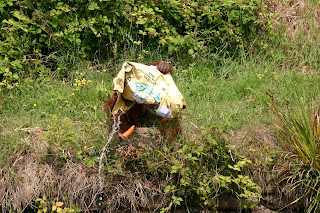Friday 18 December 2009
Thursday 26 November 2009
Lots of new people
Friday 10 July 2009
Wasiq Ashfaq's wedding
Monday 6 July 2009
Jersey's Durrell Wildlife Conservation Centre


Here is a meerkat on look-out duty at the trust. They have this Easter been housed in a new enclosure which replicates their natural habitat. Read more at http://www.bbc.co.uk/jersey/content/articles/2009/03/04/meerkats_durrell_feature.shtml

An example is its work with three types of primates – Gorillas and Orang-utans and Lemurs.
My understanding is the work with these primates is aimed at establishing breeding populations outside their natural habitat so that if as is likely their natural habitat disappears these wonderful animals will not be lost to the world.
Everything you ever wanted to know about Durrell’s Gorillas can be found at http://www.durrell.org/Animals/Mammals/Gorilla/ . There is a great gorilla video and a fact sheet which explains what has caused them to become an endangered species. Together with loss of habitat to farmland, the illegal capture of gorillas for bush meat (any wild-caught animal eaten by people), the pet trade, hunting trophies and souvenirs (gruesome novelties such as gorilla hand ashtrays), threatens the extinction of all 5 races of gorilla. Here are my photos of gorillas.

"‘African Bai’ is the new facility for our gorillas, and a planned larger group. We shall have two large outside areas, one imitating the clearings in the West African forests to which gorillas and other animal such as elephants, bongo and red river hog, are attracted. There will be a large unheated area for inclement weather, with natural vegetation, plus an indoor heated facility (the ‘day gym’) and off-show sleeping and handling facilities. Either with or adjacent to the gorillas will be guenon monkeys, red river hogs and African clawless otters "
The orang-utans are the most endangered great ape and close to extinction. It is probable in the next few years that these magnificent animals will no longer be able to live in the wild and without conservation work like that at Durrell will be lost forever. Deforestation is the main problem. All you want to know about orang-utans at Durrell can be found at http://www.durrell.org/Animals/Mammals/Sumatran-orangutan/ which includes a great video and a fact sheet.
Here are my pictures

Lemurs are not classed as great apes but are primates and are related to the earliest ones. They are only found on Madagascar. Durrell is working with red ruffed lemurs, the ring tailed lemur, gentle lemurs and a closely related species the Aye-Aye.
Details of red ruffed lemurs can be found at http://www.durrell.org/Animals/Mammals/Redruffed-lemur/ . Their chances of survival are bleak. Here’s my photo of a pair at Durrell.
 Red ruffed lemurs feeding at Durrell.
Red ruffed lemurs feeding at Durrell.Details about the gentle lemur can be found at http://www.durrell.org/Animals/Mammals/Alaotran-gentle-lemur/ . This is a critically endangered species which is being hunted to extinction for cheap meat. There are about 5000 left and in the last 5 years 30% of the population has been lost. Here are my pictures from Durrell.
 A gentle lemur from Madagascar and here is another one
A gentle lemur from Madagascar and here is another oneRing tailed lemurs are popular with tourists visiting Madagascar and although vulnerable could well survive in the wild. Read more at http://www.durrell.org/Animals/Mammals/Ringtailed-lemur/ .
Here’s my picture.
 Ring tailed lemurs at Durrell
Ring tailed lemurs at DurrellThat’s all for now
Ken
Wednesday 24 June 2009
Thanks Ken!
In case the rest of you are wondering, these are from Ken Boddington's (MSc IS) safari holiday in January 2009. Beats Leicester.
Tuesday 23 June 2009
Hipp Hipp o ray at Madikwe



Through the middle of Madikwe runs the Limpopo river and in the Limpopo there are Hippos. You can hear them several hundred yards before reaching the river. These animals are not fish eaters but herbivores leaving the river to feed at night. More people are killed by hippos than any other animal in Africa.












